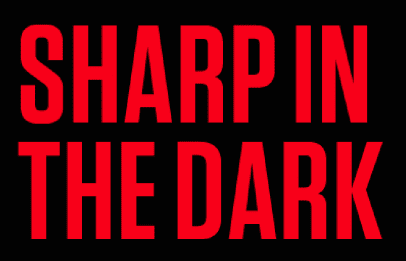The end-of-the-day traffic meant it was almost six by the time Sharp pulled up in front of 141 Fulgrove. She turned off the K-car’s engine and sized up the place. There were no lights on in the building, except for one in the third-floor apartment’s window. It was making the faded, rose-patterned curtains glow pink.
Just then, the light behind the curtains went out. Sharp leaned forward. She counted in her head — and sure enough, about 10 seconds later, the front door opened.
A figure appeared on the porch: a woman with thick, grey-black curls wearing a dark coat and carrying a purse. She walked down the front path, turned in the other direction and trotted off down the sidewalk.
A moment later, Sharp was stepping across the porch of 141 Fulgrove.
She tried the front door. It was locked. A panel of buzzers was screwed into the brick next to the front door. The last names of tenants were DYMO-taped — white, embossed type on black, shiny plastic — under each button.
Sharp bit her lip. She looked around the front porch. Circulars, junk mail and takeout food debris had gathered in the four corners of the porch. Sharp snatched up the cleanest-looking envelope she could find. It was junk mail addressed to The Owner, 141 Fulgrove. She flattened it out, then buzzed the first-floor apartment. Through the single-pane windows, Sharp could hear the buzzer’s staccato ring-ring. No answer. She tried the second floor. Again, no answer. Sharp turned around and looked at the street. Dead leaves skipped across the pavement in the wake of a passing car.
The door opened.
Sharp spun around to find a man in his early 30s, dressed in worn dark-blue jogging pants and an Argos shirt. He was staring straight at her. Sharp figured he’d missed a few appointments with a razor, judging from the amount of stubble across his face and up his neck. She also figured he couldn’t care less.
He said, “Yeah?”
Sharp stepped forward. “I’m sorry to bother you, but I have a delivery for —” Sharp split her gaze between the third-floor door bell’s name tag and the envelope in her hand: “Ms Wilbur.” (One look at the second-floor tenant told Sharp that he wasn’t running a brothel. He wasn’t running anything.)
“Just leave it in the hallway.”
“It’s from the government. A cheque, I believe. I’d like to slide it under her door myself. I know how letters can go missing. Especially important ones,” Sharp said.
“No kidding. My cheque’s late this month. I sure hope someone hasn’t taken it. We need better security around here is what we need. Anyway, Jane’s is the door at the top of the stairs,” he said, stepping aside.
“Thank you,” she said, starting up the stairs.
“Say, why do you have her cheque, anyway?” he asked slowly.
Sharp stopped. Her eyes darted for a moment, then, “It — went to my place by mistake. We used to share an apartment,” Sharp answered, breathlessly.
The first-floor tenant stared at her. Then he shrugged. “Okay,” he said, reaching into the pocket of his jogging pants and pulling out some bills.
“My cheque better come soon. I’m getting down to my last pack of smokes,” he said as the front door clunked shut behind him.
Sharp stepped onto the third-floor landing. She knocked. No answer. She swallowed, grimacing as she reached inside her jacket and pulled out two metal objects resembling dentists’ tools. She inserted one of them — a thin piece of metal, flattened at one end — into the base of the door’s lock. She twisted it to the side, out of the way, then inserted the other, a thin metal dowel, into the centre of the lock. She wiggled it around.
“Come on,” Sharp said under her breath. A sheen of perspiration appeared on her forehead.
She took out the dowel, blew on it, and inserted it again with renewed force. It scrapped against the lock opening as she jammed it around. Then she felt it. The grip of gears, the release, and she was in!
Rotating the other tool as if she were moving the hands of a clock, the deadbolt silently withdrew into its cavity.
Sharp pushed open the door and stepped into the apartment. She let her eyes adjust to the gloom . . .
When they did, she saw crimson. Walls, wood trim and doors were all painted the colour of blood. Plush 1950s chairs and a long corner couch were upholstered in bright, dark-red satin. Red-pink tendrils from the wall-to-wall shag carpet curled around Sharp’s worn leather boots.
On a lung-shaped coffee table, piles of magazines were neatly fanned. The cover of the one on top showed a naked woman, her body bathed in shadows, against a field of black satin. Porn, thought Sharp. She peered closer, puzzled. It was an Italian women’s fashion magazine.
Sharp straightened up and looked around. “Ah?” she gasped, terrified. A woman wearing a vintage men’s blazer, pants and white shirt stared at her. Sharp exhaled as her own image waved back at her from the surface of a floor-length mirror. Mirrors were everywhere — framed and hanging on the wall, leaning, even free-standing. Sharp looked up at the ceiling, expecting to see a bird’s-eye view of herself, but instead saw a plain white ceiling. She checked the other rooms: a spacious bathroom, again done up in pinky red, and two bedrooms, each with king-sized beds wrapped in dark-red satin sheets. A hallway at the end of the living room led to a cramped kitchen.
Sharp walked back into the living room. Besides mirrors, several framed photos of women in sexy poses hung from the walls. Sharp got up close to one of them. The woman was Judy Garland in mid-career. Sharp was mid-frown when she heard the footsteps. Someone was coming up the stairs.
Sharp leapt across the room and slid the deadbolt back into place, then headed for the kitchen. She moved a jade plant from the sill to the counter, lifted open the window, put her hands on the outside frame and pulled her upper body through the gap. On the roof, she twisted around, swung out her legs and started crawling.
The roof sloped more than Sharp expected. It was dark now, too. She grabbed at the rough, shingled surface, pressed herself against it and made her way toward the fire escape.
“Hello? Who’s there?” She heard a female voice calling, nervously, from inside the apartment.
She grabbed the fire escape’s paint- and rust-encrusted railing, jumped onto it, and started down, two steps at a time, her heart racing as fast as she was. She took a corner and cursed as a chunk of rust caught on her hand and ripped open the skin between her thumb and forefinger and across her palm. Stinging pain shot up her arm. She shut her hand in a dirty, wet fist and kept going.
At the same time that the second-floor tenant rounded the corner dragging on a freshly lit cigarette, the woman in the third-floor apartment swept aside the rose-patterned curtains, shoved up the front window and yelled, “Stop that man! He’s the East End Burglar!”
“Huh? The East End Burglar? But this is the west end, and that’s a she — er, I think it is?” the second-floor tenant said out loud, his forehead creasing in confusion. Then he heard the clang of the metal railing knocking against the tin drain spout as Sharp zigzagged down the fire escape. His eyes shot open. “Stop that — person! That’s the East End Burglar and he’s moving west!” A burning cigarette hit the sidewalk. “Stop you!” he hollered.
Sharp ran up to the K-car’s door and fumbled with her keys. Fat, dark drops of blood hit the pavement.
The tenant ran up, panting, as the K-car pulled away from the curb and swerved down the street.
“Oh, Angus, you almost had him,” Jane Wilbur shouted down from the third-floor window, her voice laced with disappointment. “Angus?” she called again.
Angus, the second-floor tenant, watched the K-car take the corner on two wheels, his eyes in a tight, concentrated squint.


 Why you can trust Xtra
Why you can trust Xtra


